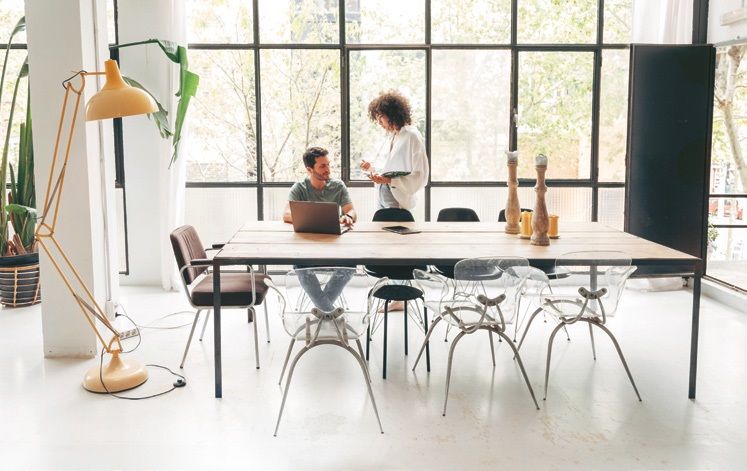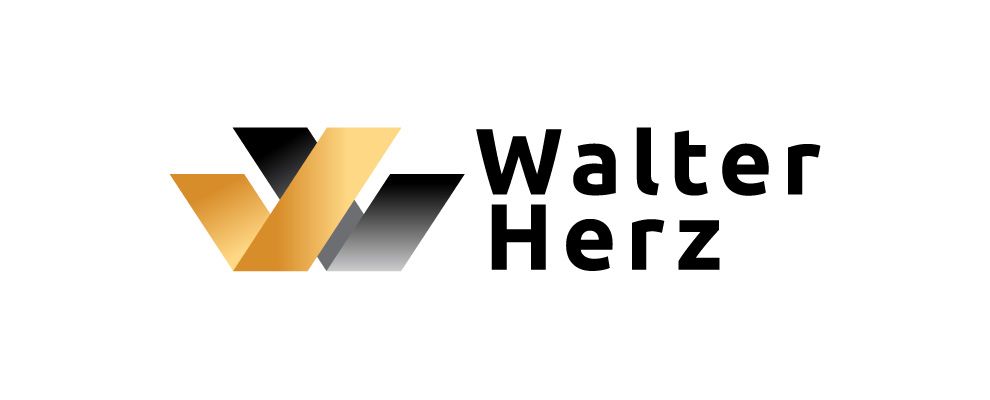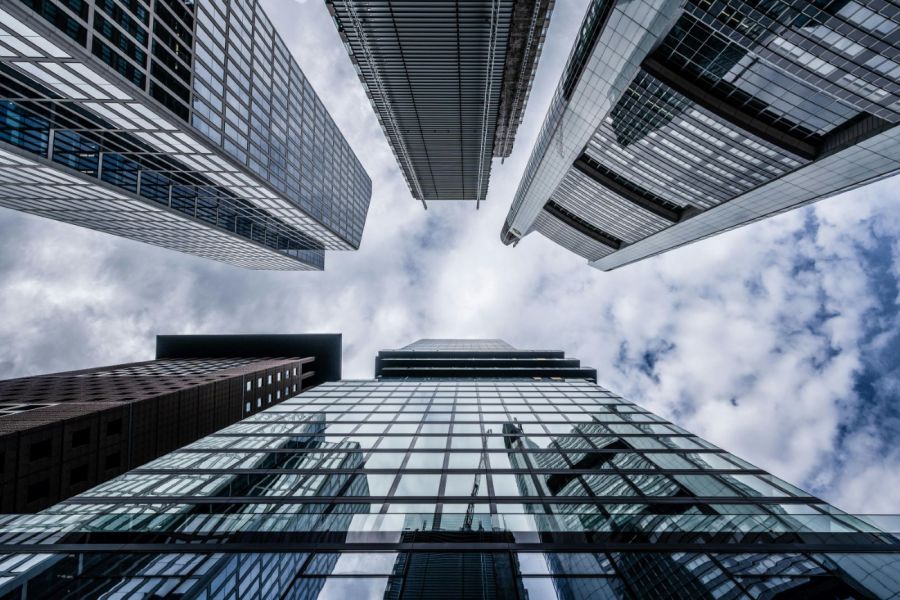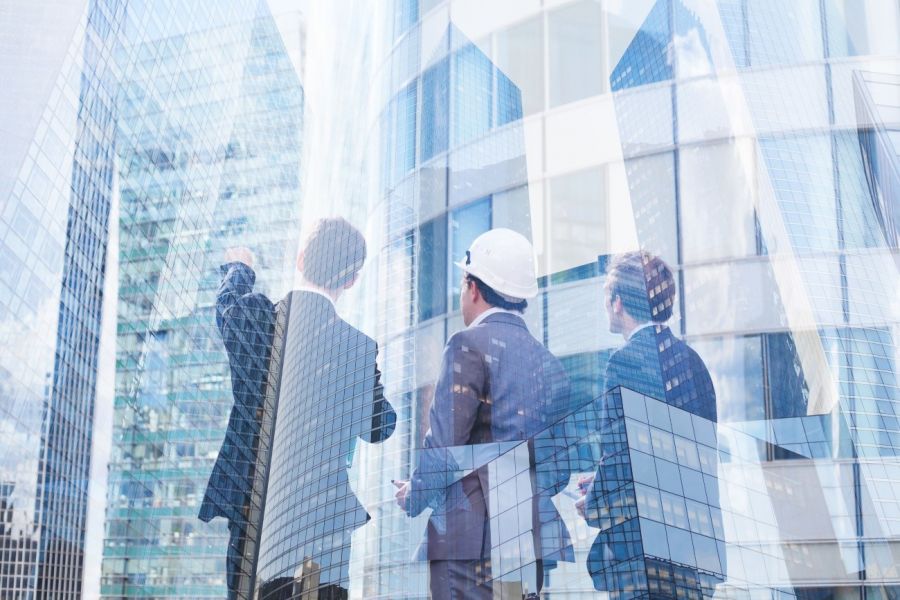Office interior design optimized for hybrid work in the business services sector

How are offices adapting to the demands of mobility, sustainable development, and digitization? How are they shaping a workplace that goes beyond traditional office spaces?
Space optimization, improving the quality of offices, searching for more attractive locations and ESG-compliant properties with intelligent technological solutions, providing practical amenities and services are the main trends that will intensify on the office market this year. Workplaces will become increasingly diversified in terms of functionality, designed in a flexible way to meet the individual needs of employees.
A new function of office space
During the widespread period of hybrid work, offices gained a new function: they are primarily intended to support teamwork, encourage people to give up the home office and integrate the team. The design of space is supporting this goal, in terms of layout, division of space and equipment. In the area of work-life balance, organizations are looking for an alternative to working from home in order to encourage employees to go back to their offices.
Today’s office is becoming a hub for project meetings and cooperation, a place for employee integration. It is becoming increasingly multi-functional to provide what people lack at home. The interior divided into different zones makes it suitable for focused work, teamwork, on line meetings, as well as relaxation during breaks.
Human-centered design
Today, office design is focused on creating attractive, functional spaces that support the well-being and development of employees, taking into account their individual needs. The idea is to design offices in such a way that they create places that foster associations people want to come back to. The workspace must be comfortable, friendly and tailored to the team’s preferences, as well as attractive in terms of decor.
Preparing offices for a hybrid work system aims to maximize the illumination of the space, ensure appropriate air quality, humidity and room acoustics. Creating ergonomic workstations and various zones for work and rest.
Office design increasingly reflects natural human needs. Office interiors are filled with greenery, which has a relaxing effect. The office is supposed to provide comfortable working conditions, but also many attractions and entertainment that one can enjoy during breaks from work. All this so that employees are happy to use it. The precursors of this type of office interior designs in the pre-pandemic era were such companies as Microsoft, Google and Facebook.
Noisy open spaces with numerous, densely packed desks are becoming a thing of the past. Open collaborative work zones are replaced by quiet spaces for project work, meeting rooms of various sizes, spaces enabling convenient online meetings and presentations, and places for informal meetings. The way they are arranged is becoming more and more diverse to respond to the different needs and predispositions of employees.
The space is intended to support creativity and create friendly conditions for the exchange of opinions, discussions and associations between people.
Offices adapted to mobility
Organizations in the BSS/SSC sector are becoming increasingly dispersed in terms of space and organization. Therefore, solutions that enable high mobility are necessary. Technology tools that can be synchronized and create platforms accessible to all employees enable work from the office and from any other place.
The demand to create increasingly functional spaces has made offices more flexible. They combine permanent, dedicated workstations with the so-called hot desks used by many people in accordance with their current needs.
Designing is aimed at maximizing the functionality of workplaces. Elements that do not serve practical purposes are removed from office spaces, and useful tools that promote work efficiency and are used by employees on a permanent basis are expanded. The interior design tends move towards functional minimalism.
Sustainability and savings
The growing importance of ESG criteria results in an increase of interest in certified buildings. When choosing an office, companies pay attention to whether the office building is adapted to the EU ecological requirements.
Environmental protection and social responsibility become a priority. Modern offices focus on reducing the impact on the environment by reducing water and energy consumption and efficient use of resources, including the implementation of a zero waste policy and other pro-ecological activities, including recycling.
Organizations focus on modern real estate, equipped with technologies that improve the working environment, with a health-promoting profile and advanced air filtration systems, as well as contactless technologies, which have a positive impact on employee productivity.
Intelligent solutions and optimization of management processes
2024 on the office market will be another year of digitization. Companies are consistently investing in modern technologies and tools that enable more effective use and management of leased office space.
The quality of cameras, microphones, screens, furniture and lighting is intended to provide meeting participants with the highest possible transmission quality, which is taken into account already at the stage of designing and equipping new offices. Office space has a significant advantage over working at home, where it is not possible to achieve such high quality remote meetings. It’s also about building positive user experiences.
In addition, organizations will continue to invest in modern buildings that provide technological solutions and applications for the efficient use of space. Thanks to them, one can remotely manage access and monitor the use of space. Conveniently book parking spaces, conference rooms, use elevators contactlessly, choose space in co-working, automatically open doors or enter the office.
Higher quality of space and attractive address
Almost three years after the hybrid work system became popular, companies are able to more easily estimate how much space they actually need. The trend of reducing space is widely visible, also due to the increasingly higher costs of maintaining offices. The average rented space has been decreasing for several quarters. At the same time, co-working spaces are becoming more and more popular.
Companies are moving from older properties to new buildings, central locations that offer a number of amenities and access to services, both in the building and in the immediate vicinity. They are giving up outdated office buildings in favor of attractively located buildings offering high-quality space. The most sought-after offices are in the central areas of cities, which provide wide access to public transport. Companies decide to reduce the office space they occupy in favor of more prestigious addresses and increase the efficiency of space use.
Author: Mateusz Strzelecki, Partner and Head of Tenant Representation, Walter Herz
This article comes from magazine:
FOCUS ON Business #15 March-April (2/2024)
 Check the issue
Check the issue








